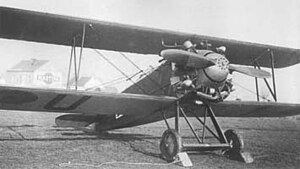PWS-A
| BH-33 | |
|---|---|
 |
|
| Role | Fighter |
| Manufacturer | Avia, PWS (under licence), Ikarus (under licence) |
| Designer | Miroslav Hajn and Pavel Beneš |
| First flight | 21 October 1927 |
| Primary users |
Czechoslovak Air Force Polish Air Force Yugoslav Royal Air Force |
| Produced | Ca. 110, plus 50 licence-built in Poland and 22 in Yugoslavia |
| Developed from | Avia BH-21 |
The Avia BH-33 was a biplane fighter aircraft built in Czechoslovakia in 1927. It was based on the BH-21J which demonstrated promising results by combining the original BH-21 airframe with a licence-built Bristol Jupiter radial engine. Other than the peculiar Avia hallmark of having an upper wing with a shorter span than the lower, it was utterly conventional, even featuring a tail fin for the first time in a Pavel Beneš and Miroslav Hajn design (previous aircraft had a rudder but no fin).
Initial tests of the first prototype were disappointing, displaying performance only marginally better than the BH-21, even when fitted with a more powerful version of the Jupiter. Two further prototypes followed, both designated BH-33-1, each with an increasingly powerful Jupiter variant - one a Jupiter VI, the other a Jupiter VII. The performance of the latter example was finally acceptable for the Czechoslovakian defence ministry to order a small production run of only five aircraft.
Three examples were sold to Belgium, where there were plans to build the type under licence, but this did not occur. Licence production was undertaken, however, in Poland, where a single example was sold, along with a licence to build 50 aircraft. These were designated PWS-A and put into service with the Polish Air Force in 1930.
Development continued with an almost total redesign of the fuselage, replacing the wooden, slab-sided structure with one of oval cross-section, built up from welded steel tubes. Designated BH-33E, this was a world-class fighter for its time. Nevertheless, the response from the Czechoslovakian military was lukewarm (although two were bought for the national aerobatics team), and Avia again looked abroad for customers, this time selling 20 aircraft to the Kingdom of Yugoslavia, along with a licence to produce another 24. Two or three examples were also bought by Russia for evaluation.
...
Wikipedia
